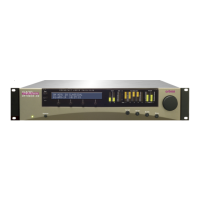OPTIMOD-AM DIGITAL INSTALLATION
2-39
vacuum-tube plate-modulated design) may fail, may have their tube life
shortened, etc. Such transmitters are simply incapable of supplying the
average power demands of OPTIMOD-AM processing regardless of
transmitter equalization. If the station is to achieve the full benefits of
OPTIMOD-AM processing, these transmitters must be either repaired,
modified, or replaced.
16. If you will be using other Transmission Presets, repeat steps 11 through
15 to set them.
Substitute
the name of the Transmission Preset under adjustment for “TX1/D
AY”
in these steps.
Do not forget the set the L
OWPASS, HIGHPASS, and POS PEAK controls for each
Transmission Preset that you use.
17. Set Digital Radio output level.
A) Navigate to
SETUP > IO CALIB > OUTPUT > DIGITAL[X] (where “x” is the output
you are using to drive the digital radio transmitter.
B) Set the output level to match the clipping level of the digital radio input. Re-
fer to the transmitter manufacturer’s instructions to obtain the correct level.
IMPORTANT: Do not use the output level control to turn down the loud-
ness of the digital channel if it is louder than the analog channel on an
HD AM receiver. Instead, turn down the HD
LIMITER DRIVE control in the
on-air preset and save the resulting edited preset as a User Preset. Using
the HD
LIMITER DRIVE control minimizes the amount of peak limiting that
the 9400 does, thereby minimizing stress on the codec.
18. End I/O setup.
If you are using a external AGC and you temporarily set the E
XT AGC to NO in
step 1 on page 2-23, set the E
XT AGC to YES.
19. Select a processing preset.
See step 15 on page 2-22.
Automation Using the 9400’s Internal Clock
1. If you have not already done so, set the system clock.
[You can also set the clock automatically via PC Remote or the Internet. See
Synchronizing Optimod to a Network Time Server starting on page 2-55.]
A) Navigate to S
ETUP > NEXT > TIME DATE AND ID > SET TIME.
a) Set hours and minutes.

